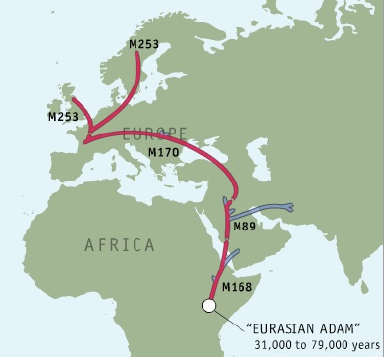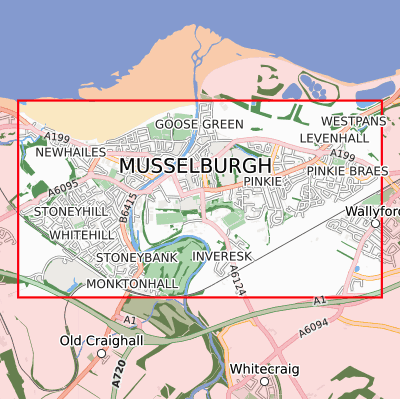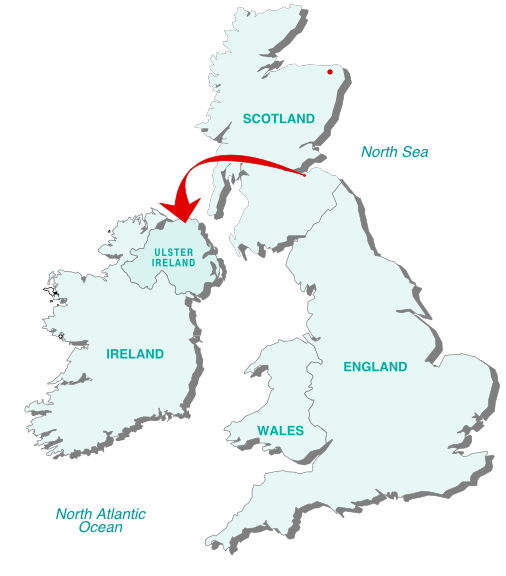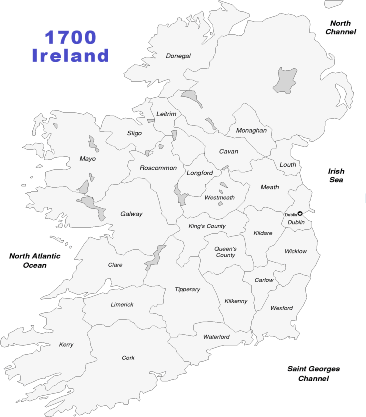|
|
 Our Early Jameson History - a little background
Our Early Jameson History - a little backgroundOur particular Jameson family, regardless of it's various spellings and translations,[1] has it's early history in the British Isles. We are of Scottish origins, with our earliest verifiable records from the Midlothian area, not far from Edinburgh, in the 1600's and early 1700's.[2]
OUR MOST ANCIENT ANCESTORS

![]() Genetic science is able to help us identify our earliest possible ancestors from thousands of years ago, but only in a somewhat general anthropological way. Genealogical DNA testing indicates those who eventually became our Jam?son family would have belonged to a specific group of people, they themselves undoubtedly descended from others originally of the African continent, who can be found some 15,000 to 20,000 years ago in the Iberian Refugia (Spain), during the last ice age. Their subsequent migration patterns, after the ice finally began it's slow retreat, would have been a northern movement through France and then on to a northeastern loop into what is now Germany and Denmark, then into all of Scandinavia. Eventually, some from this group migrated westward into the British Isles and Iceland. Some say our particular ancestor group didn't genetically format into it's present profile until about 3,000 to 5,000 years ago (3000-1500 BC), somewhere in northern Europe, probably Denmark.[3] Nevertheless, everyone pretty much agrees with the general migration patterns, as well as all other modern results.
Genetic science is able to help us identify our earliest possible ancestors from thousands of years ago, but only in a somewhat general anthropological way. Genealogical DNA testing indicates those who eventually became our Jam?son family would have belonged to a specific group of people, they themselves undoubtedly descended from others originally of the African continent, who can be found some 15,000 to 20,000 years ago in the Iberian Refugia (Spain), during the last ice age. Their subsequent migration patterns, after the ice finally began it's slow retreat, would have been a northern movement through France and then on to a northeastern loop into what is now Germany and Denmark, then into all of Scandinavia. Eventually, some from this group migrated westward into the British Isles and Iceland. Some say our particular ancestor group didn't genetically format into it's present profile until about 3,000 to 5,000 years ago (3000-1500 BC), somewhere in northern Europe, probably Denmark.[3] Nevertheless, everyone pretty much agrees with the general migration patterns, as well as all other modern results.
It may be interesting to know that our family's proven general genetic group[4] is shared by at least two different known migrations into the British Isles, from the same ancient peoples. One from the massive and well known migration in the early fifth century, from the area of what is now Denmark and Germany into England, by a people known as Anglo-Saxons who are sometimes thought of as the "permanent invaders."[5] Our general genetic group is also the same as that from a later migration of Vikings westward into Scotland, as mentioned above. In addition it can also be said that our general genetic group, can also be found amongst the Normans who came to Britain in the tenth century, probably Franco forebears of those who ended up migrating eastward from ancient times, or Vikings who could be found in Normandy at the time the Normans invaded England. One thing we do know, is that our DNA profile excludes any chance our family is descended from the Celtic Picts, who were indigenous to what is now northern and eastern Scotland during Late Antiquity and the Early Middle Ages. That is also the case with Romans, who had very little to do with Scotland, while in the British Isles.
Given our particular family's genetic make up and because we are widely thought to be from Scotland, we would have probably been of Nordic forefathers, through Viking conquests and migrations, possibly dating back as far as the seventh or eighth century. Our patriarchal genetic profile appears to substantiate this. We do not know when or where they may have first arrived. However, it would be safe to say they were definitely there before the use of surnames in the fifteenth or sixteenth century. Long enough ago to now be considered as an integral and structural part of that ethnicity.
Our particular Jam?son family did not exist until the use of surnames, before that we were just "Johns and Thomases and "James'" and "Peters" etc., although our genetic strain was still the same as it is now. Unfortunately, the time before surnames is almost impossible to verify, because there were so few records kept. In fact the reason for surnames in the first place was to keep records, often for tax and other organizational reasons. Few family surnames were used before the fifteenth or sixteenth centuries in what we now known as the United Kingdom, or the British Isles.
SCOTLAND

![]() It appears our oldest known Jam?son ancestors in Scotland were all from the area of Inversek and Musselburgh, in eastern Midlothian, Scotland, not far from Edinburgh. We believe they are all descended from a Edward Jamesone, Burgess of Musselburgh, probably born about 1550 and died there about 1624.[6] There were a fair number of these Jamesons, several with names of the children and grandchildren, particularly Edward, John, Alexander and Thomas[7], who align and match with those known to us in Ulster and later again in New Hampshire, each with appropriate dates and groupings. Although there is no official or verifiable records for any of this, we feel these details speak for themselves and both explain and substantiate our connection. Again, this is all understandably somewhat circumstantial and speculative, but very plausible, persuasive and quite likely.
It appears our oldest known Jam?son ancestors in Scotland were all from the area of Inversek and Musselburgh, in eastern Midlothian, Scotland, not far from Edinburgh. We believe they are all descended from a Edward Jamesone, Burgess of Musselburgh, probably born about 1550 and died there about 1624.[6] There were a fair number of these Jamesons, several with names of the children and grandchildren, particularly Edward, John, Alexander and Thomas[7], who align and match with those known to us in Ulster and later again in New Hampshire, each with appropriate dates and groupings. Although there is no official or verifiable records for any of this, we feel these details speak for themselves and both explain and substantiate our connection. Again, this is all understandably somewhat circumstantial and speculative, but very plausible, persuasive and quite likely.
Regardless of who or where, our Jamesons were from, before they were known as Jamesons, they were undoubtedly members of some Scottish clan during the time they lived, wherever that was. Almost everyone was a member of a clan as the "rule by clan" society was generally accepted as a way of life in Scotland during those times, although less so in the Lowlands, at least by the end of the 16th century. There were many clans in the areas where we are thought to be originally from, including: Stewarts, Campbells, MacNabs, MacLarens, Grahams, etc. Although no known clan affiliation exists with our Jameson family, the Jam?son surname is often associated with Clan Stewart and especially one of it's main branches, Clan Stuart of Bute, from the Island of Bute, of which the surname Jameson is often specifically listed as a sept. Jameson was also a well known sept of the Clan Gunn from the far northeastern part of Scotland, to which many Jameson families consider their heritage. However no known connection exists between the Jamesons of Clan Gunn and our Jameson family. The Jameson families in the Lowlands border areas would also be thought of as clans, although in a less traditional way. Here too we know of no direct connections with our Jameson family. Any real connection with ANY clan, will need be made with YDNA testing. More details about clans and our family here.
The lives and circumstances of the Jamesones in the Musselburg area of Scotland, especially in the latter half of the seventeenth century were tumultuous and complicated. Many of these Jamesones were Presbyterian Ministers caught up in the difficulties with issues of those times, some even persecuted. One in particular, Edward Jamesone (1624-1707), a direct ancestor (father) of several of the people we can find in Ulster, may have been the reason for them being in Ulster, probably fleeing certain difficulties.
IRELAND
At the beginning of the 17th century King James I, of England, began a repopulation of northern Ireland with mostly Scottish Protestants.[8] The area was at the time largely occupied by the Desmonds, who had been defeated and depleted in various rebellions with the crown during the reign of Queen Elizabeth. This forced repopulation started in 1611 and was an effort by the king to colonize this here-to-fore troublesome area with a more sympathetic and supportive people. The incentives were lucrative with large quantities of land available for each immigrant. Many Scots took advantage of this offer and is undoubtedly why our Jameson ancestors found their way to Ireland. This population was largely increased with further immigration over the next fifty years as a result of persecutions by English Kings Charles I and Charles II in their effort to establish the Church of England in Scotland.
The Scottish colonists resided in Ireland for over several decades during the middle 1600's on into the 1700's. They lived somewhat autonomously, retaining their culture and traditions. Intermarriages of the Scots with the indigenous Irish during that time was exceedingly rare, so that the Scotch race remained nearly as distinct as it was prior to its settlement in this new land. They attended their own churches and continued life pretty much as it was known to them in Scotland.
 Our Jameson family was part of this early Ulster repopulation, although we do not know exactly when they made their migrations, nor do we know where exactly they migrated from or where in Ulster they first settled. The earliest we know about them is from a 1669 taxation document known as the Hearth Money Rolls.[9] This shows an Alexander and a Thomas Jamesone in the area of Ballymoney in County Antrim. They are believed to be the ancestors of our Jonathan, Alexander, Thomas and Hugh Jameson (and probably others) who eventually emigrated to New England in the early 1700s.
Our Jameson family was part of this early Ulster repopulation, although we do not know exactly when they made their migrations, nor do we know where exactly they migrated from or where in Ulster they first settled. The earliest we know about them is from a 1669 taxation document known as the Hearth Money Rolls.[9] This shows an Alexander and a Thomas Jamesone in the area of Ballymoney in County Antrim. They are believed to be the ancestors of our Jonathan, Alexander, Thomas and Hugh Jameson (and probably others) who eventually emigrated to New England in the early 1700s.
How they came to settle here we don't know. It is possible they came here from an earlier arrival some other place in County Antrim. Or, it is possible they arrived in Ireland as part of the Londonderry Plantation. This was a planned settlement in western Ulster in the county of newly named Derry[10] and covered the area from the River Foyle on the west, eastward to the Bann River. On the west was the old city of Derry now renamed Londonderry[11] and on the east was the town of Coleraine.[12]
Coleraine, and the surrounding Bann River Valley area, was one of the two larger communities developed by the London Companies during the Plantation of Ulster at the start of the 17th century. Coleraine has a long history of settlement. In fact, the Mesolithic site at Mount Sandel, which dates from approximately 5935 BC, has some of the earliest evidence of human settlement in Ireland. Our particular Jamesons seems to have been mostly in this area, although there undoubtedly may have been some who ended up elsewhere in the same general area, such as at least one family we know of in Belfast.
Many other Jam?sons can be found in the Bann Valley, some to this day. Several of these Jam?sons are thought to be somehow related to our Jamesons who emigrated in the early 1700s, although most have not been proved.
In the latter part of the 17th century King James II of England, the last Roman Catholic King, was disposed of his throne. Determined to regain the crown, he went to Ireland where he raised an army of over 40,000, "wild Irishmen" and had some additional help from the French, thanks to Louis XIV. One of his first acts was an attempt to rid the country of King James I colonists, believing that because they were of a different religion, would never support his monarchy. The wholesale destruction of life and property that followed in the wake of his army caused most of the remaining colonists, about 30,000 in all, to take refuge in Londonderry, or Derry, the place of oaks, as a city of refuge, and to take shelter behind it's walls. Here they were besieged and blockaded for one hundred and five days. They gave James' army a stubborn fight, killing 8,000. They themselves lost 4,000 of perhaps what may have been only 7,000 effective men. A great many more of the besieged perished of hunger and disease than were killed by the guns of the Irish attackers. Nearly every cellar in the town was said to have been occupied by the putrefying remains of those who died so fast that they could not be buried. The dogs who fattened on the blood of the slain were greedily devoured by the starving people. Even the rats that came to the disaster furnished "meat for the eaters." A soldiers rations were a half pound of tallow and three-quarters of a pound of horse hide per day. Might it not have been here where Darwin obtained his theory of "the survival of the fittest?
Many families did survive this siege, and with the arrival of the army of William III, the Prince of Orange and new King of England, fought the Battle of Boyne, June 30th and July 1st 1690[13] They, in one of history's most decisive battles, soundly defeated and destroyed James' army, forcing him to flee to France where he lived until his death in 1701.
A William Jameson was said to have served in the defense of Londonderry during the siege in 1689, and probably in the Battle of Bone in 1690, with such distinguished gallantry and bravery that he was exempted from taxation throughout the British Dominion.[14]
DIFFICULT TIMES
Unfortunately, by the Test Act of 1704 under Queen Anne (1702-1714), the Scots in Ulster lost every benefit of the Tolerant Act of May 24, 1689, gained under King William. The policies virtually made the people outlaws, and were deprived of their chapels and schools, invalidated their marriages, and prohibited anyone from office above that of petty constable. For these and other reasons emigration out of Ireland, and for that matter all of the British Isles and Europe has continued ever since, particularly from Ireland during the famines in the middle 1800's. This of course included people from our particular Jameson family. Migrations of all kinds to practically everywhere on earth have made this a small world in the time since our Jameson ancestors moved to Ulster in the 1600's. It can be assumed that one can now find a Jameson of our family practically anywhere on this globe.
Although James II was driven from Ireland, sectarian violence continued between Irish Catholic and Irish Protestants, indeed to this day. Ireland eventually divided itself into the independent Republic of Ireland and Northern Ireland, which remains a part of the United Kingdom.
Other, more specifically detailed, related pages of interest:
![]() Our Scotland Jamesons - An in-depth examination of the Jamesons, particularly our Jamesons, in Scotland - starting in the beginning of the 1600's and then since.
Our Scotland Jamesons - An in-depth examination of the Jamesons, particularly our Jamesons, in Scotland - starting in the beginning of the 1600's and then since.
![]() Our Ulster Jamesons - An in-depth examination of the Jamesons, particularly our Jamesons, in Ulster, Ireland - starting around the latter 1600's and then since.
Our Ulster Jamesons - An in-depth examination of the Jamesons, particularly our Jamesons, in Ulster, Ireland - starting around the latter 1600's and then since.
![]() Our Early American Jamesons - An in-depth examination of our early immigrant Jamesons, in Colonial New England - starting in the early 1700's.
Our Early American Jamesons - An in-depth examination of our early immigrant Jamesons, in Colonial New England - starting in the early 1700's.
| [1] | MacKechnie, McKinny or MacHamish in Galeic. Jameson, Jamison, or Jamieson, sometimes Jamerson and even Jamesoun. In early time it is sone times spelled with an "e" at the end. See here for a more thorough explanation. |
| [2] | Our Jamesons in Scotland |
| [3] | Our Ancient Historical Profile - DNA Haplogroup |
| [4] | YDNA Haplogroup "I-M253" (eye). See here for a more thorough explanation. |
| [5] | As proven by YDNA testing. See here and here for a more thorough explanation |
| [6] | The Commissariott Record of Edinburgh, Register of Testaments Part II, Volumes 35 to 81, p.212 - 1601-1700 - Francis J. Grant, W.S., 1898/a> |
| [7] | National Records of Scotland |
| [8] | Predominately Presbyterians. |
| [9] | [S129] 1669 Hearth Money Rolls for North Antrim - transcript here. |
| [10] | Which until then had been County Coleraine, one of the original 32 counties of Ireland |
| [11] | The new planned settlement was originally comprised of a single parish (Templemore), on an elevated site, originally known as ‘the island’, which shared property rights with kinsfolk and other fellow settlers in the surrounding liberties. |
| [12] | Family Formation in a Colonial City: Londonderry, 1650-1750 - by Colin Thomas, School of Environmental Studies, University of Ulster, Coleraine - Received 14 October 1998. Read 7 February 2000. Published 15 September 2000. |
| [13] | This is incidentally, the origin of the term "Orangemen" or "Orange Irish". Those, who fought with/for the Prince of Orange, during the Battle of Boyne in 1690. It has now come to be used to generically identify Protestant Irish. |
| [14] | [S2] Jameson's in America E.O.Jameson - The Rumford Press -1901 - pp305 |